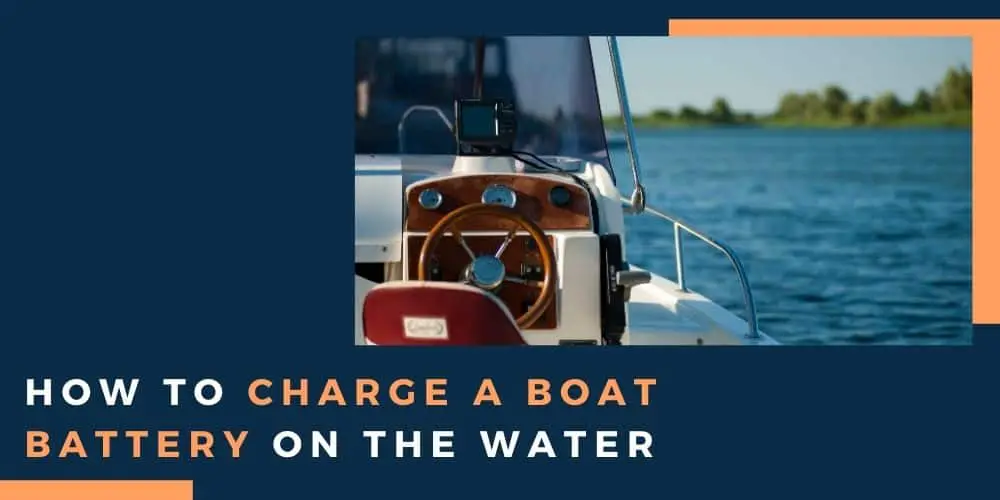So, you‘ve got your new boat and it has a marine deep cycle battery in it. At this point you are probably excited to get out on the water while the battery is pre-charged, but you’re likely also wondering how to charge a boat battery on the water if you need to.
First off, your alternator is going to keep it charged while you are using the motor but if you do need to charge it manually it’s just a matter of inspecting it, connecting it, and waiting for it to charge. You can even get a little fishing done while you wait!
Today we’ll talk about charging up your marine deep cycle battery. We’ll go over charger types, steps for charging, and the stages of charging so that you know what is going on at a basic level during the charge cycle.
Let’s discuss charging your boat on the water!
Contents
Portable versus Onboard chargers
You’ve got 2 options when it comes to charging your boat. The first is a portable charger. Easy to carry (and consequently easy for someone to carry off), your portable charger offers you a way to get that deep cycle battery recharged, but depending on whether or not it comes with a voltage regulator to shut it down when it’s done you might have to check it every hour.
Your second option for charging is an onboard charger. These are much preferred to portable and for good reason. For one thing, they’re built in, so if someone wants to get your charger they’ve got a serious job ahead of them.
Secondly, they are capable of multi-stage charging, which is faster and more efficient to the point that it can actually extend your battery’s life-cycle.
Multistage charging – Here is how it works
Multistage charging is a process that is broken down into 3 distinct phases. They are as follows:
- Bulk charging – The first stage of charging, Bulk charging is where your battery receives the highest amount of current during the overall charging phases. Simply put, it is giving your battery all of the juice that it can safely handle, while factoring in voltage increase in your battery. Typically this comes in at 10 – 25% of your battery’s amp hour capacity.
- Absorption phase – This is the point of charging where your battery is starting to stabilize and the current is decreasing so as to ‘top it off’, instead of flooding it as it does during Bulk charging. Your battery typically registers 14.1 – 14.8 volts at this stage and a predefined set-point in your charger helps to ensure that the current flow is slowly leveled, but constant.
- Float mode – The final stage of charging, when you are in ‘float mode’ the charging current drops to almost 0, allowing the battery to lower its overall voltage to a range of 13.5 to 13.8 volts. While in float mode, you stay at a perpetual ‘fully charged’ state until the charge cycle terminates and you begin routine use once more.
Steps for charging your boat on the water
Now that you know what is going on internally during multi-stage charging we should go over the steps to actually initiating the charging process.
If you have access to a marina then you can easily charge while your boat is still on the water.
You’ll want to plug your charger into a 120 volt outlet and then you must do the following:
- Step 1 – Make sure that everything is shut off and give the battery a spot clean and quick inspection. You can remove any dirt buildup that is present so that you won’t have to deal with a worse version of it next time and then you should check your connections to make sure that they are whole and as corrosion free as you can get them.
- Step 2 – Connect up your battery charger to the deep cycle battery’s terminals so that we may begin the charging process.
- Step 3 – Start your charger and let it do its work. If you are using a smart, multi-stage charger then you will likely have an LED readout to indicate the stages as it goes along. Let it run to completion and you are done. If you are using a portable, however, then Step 4 applies for you.
- Step 4 – If you have a voltage regulator then you can connect to your battery and do whatever you like during the charge process. If your portable does NOT have a regulator then you will want to check the voltage hourly until the charge is done.
| Image | Title | Price | Prime | Buy |
|---|---|---|---|---|
 | NOCO GENIUS5, 5-Amp Fully-Automatic Smart Charger | PrimeEligible | Latest Price on Amazon | |
 | Schumacher SC1280 15 Amp 3 Amp 6V/12V Smart Battery Charger | PrimeEligible | Latest Price on Amazon | |
 | TACKLIFE T8 800A Peak 18000mAh Lithium Battery Booster | PrimeEligible | Latest Price on Amazon |
Some final words if you are using a portable
While onboard chargers are nice, we realize that you may not necessarily have one on your boat and so we wanted to address voltage regulation on portable chargers.
If you don’t have it, charging can be a bit of a chore, so we recommend that you invest in a charger that has this feature.
Voltage regulation helps to ensure that you don’t overcharge your battery so it is well worth the additional investment. Remember, overcharging can reduce the life of your battery so it pays to be proactive.
If you are using a portable then get one with voltage regulation if you can.







